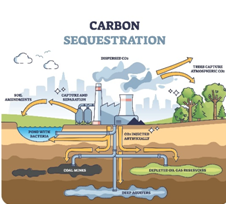

Context
Germany plans to enable underground carbon storage at offshore sites, pushing ahead with a much-discussed technology in an acknowledgment that time is running out to combat climate change.
Dimension 1: The CCS Approach
- Capturing: Carbon capture and storage (CCS) is the separation and capture of carbon dioxide (CO2) from the emissions of industrial processes prior to release into the atmosphere and storage of the CO2 in deep underground geologic formations.
- Approaches: The most well-developed approach to storing CO2 is injecting it underground into naturally occurring, porous rock formations such as former natural gas or oil reservoirs, coal beds that can’t be mined, or saline aquifers.
|
The North Sea and the area off the US Gulf Coast contain several saline aquifers. |
- Geological sequestration: Once CO2 has been captured using CCUS technology, it’s pressurised and turned into a liquid-like form known as ‘supercritical CO2’. From there it’s transported via pipeline and injected into the rocks found in the formations deep below the earth’s surface. This is a process called geological sequestration.
|
Difference between Carbon Capture and Carbon Storage
|
Dimension 2: Can Sequestered Carbon Escape?
- Carbon stored underground could find multiple ways to escape and seep back into the atmosphere due to chemical reactions that take place between the carbon dioxide, rocks, water in the pores and even the cement from abandoned wells.
- If these emissions escape, this would add to existing greenhouse gas emissions which exacerbate global warming.
Dimension 3: What about India?
- Carbon capture and storage (CCS) is vital for India to be self-reliant, achieve net-zero GHG emissions by 2070, and ensure a just transition.
- Despite India promoting renewable and alternative energy sources, long-term projections show that to meet the growing energy demand of power systems and industries, fossil fuels will need to remain an integral part of India’s energy economy.
- Cumulatively, India will have to inject 5.3–10 gigatonnes (Gt) of CO2 by 2050 to mitigate fossil fuel use–based emissions under 1.5°C temperature increase scenarios.
What is Germany’s Plan?
- Germany’s target: Germany (home to many energy-intensive industries) aims to cut its emissions to "net zero" by 2045.
- The International Energy Agency estimates that 100 billion tonnes of CO2 must be stored by 2060 to limit temperature rise to 2 degrees Celsius.
- The proposed “carbon management strategy” foresees enabling the transport of carbon dioxide and its storage under the sea in Germany’s exclusive economic zone, except in marine conservation areas.
- It doesn’t foresee allowing storage sites on land.
|
Neighboring Denmark last year launched an ambitious project that aims to bury vast amounts of carbon dioxide beneath the North Sea. |



